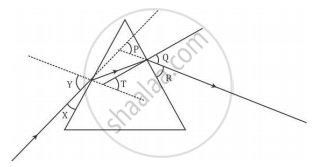Advertisements
Advertisements
प्रश्न
Explain briefly, with the help of a neat labelled diagram, how white light gets dispersed by a prism. On which surface of a prism, there is both dispersion and deviation of light, and on which surface of the prism, there is only deviation of light ?
उत्तर
When white light is incident on the first surface of a prism and enters in glass, light of different colours due to different speeds in glass, is refracted or deviated through different angles. Thus the dispersion of white light into its constituent colours takes place at the first surface of prism.

On the second surface, only refraction takes place and different colours are deviated through different angles. As a result, the colours get further separated on refraction at the second surface (violet being deviated the most and red the least).
APPEARS IN
संबंधित प्रश्न
In the following diagram, the path of a ray of light passing through a glass prism is shown:

In this diagram the angle of incidence, the angle of emergence and the angle of deviation respectively are (select the correct option):
(A) X, R and T
(B) Y, Q and T
(C) X, Q and P
(D) Y, Q and P
In the formation of spectrum of white light by a prism:
which colour is deviated least?
Make two diagrams to explain refraction and dispersion.
The coloured light having the maximum speed in glass prism is:
(a) blue
(b) green
(c) violet
(d) yellow
The frequency range of visible light is from 3.75 × 1014 Hz to 7.5 × 1014 Hz. Calculate its wavelength range. Take speed of light = 3 × 108 m/s.
The wavelength range of white light is ______.
A student has to trace the path of a ray of light through a glass prism. List four precautions he should observe for better results.
State two uses of ultraviolet radiation.
Suggest one way, in each case, by which we can detect the presence of Infrared radiations.
Say TRUE or FALSE
After passing through a prism, white light splits into a band of seven colours
